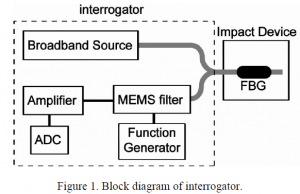Spencer Chadderdon and Dr. Richard Selfridge, Electrical and Computer Engineering
Fiber Bragg gratings (FBG) sensors are useful for static and dynamic event monitoring which make then suitable for a wide variety of applications. Dynamic interrogation of FBG sensors has primarily been performed using peak-tracking methods that have repetition rates approaching the megahertz range. However, tracking the variations in the peak response of a FBG sensor reflection spectrum can result in inaccurate measurements. For example, when under the influence of vibrations, acoustical noise, and transverse strains FBG sensor spectra associated with impact and vibrations not only have peak shifts, but the reflection spectrum can exhibit dramatic spreading or even peak splitting.
This paper describes the development and testing of an FBG interrogator that measures the FBG reflection spectrum at high repetition rate. After a description of the system and a discussion of the limitations on the repetition rate we present the experimental results from two dynamic strain events. These tests are of a woven carbon fiber composite and an electromagnetic railgun.
Below shows a block diagram of the FBG interrogation system. Single or multiple FBG sensors are placed at the end of a 50/50 splitter. The FBG sensors reflect portions of the broadband source to a MEMS optical filter that incorporates a photo detector. The resulting time-varying signal is amplified and then captured using a high-speed analog-to-digital converter (ADC).

The MEMS filter component is created by Nortel Networks and uses a Fabry-Pérot (FP) cavity consisting of two thin film reflective membranes separated by an air gap. The cavity transmits a narrow 60 pm wide wavelength band and reflects all other wavelengths. The transmitted wavelength is a function of the separation distance between the two membranes, and is controlled by an applied voltage. The interrogator uses a function generator to create a biased sinusoidal voltage that repetitively sweeps a previously defined range of wavelengths. The free running oscillation of the MEMS filter allows it to avoid settling time problems.
The ADC card used in the interrogator is the Compuscope 14200 produced by Gage (Lockport, IL). The ADC card has 14-bit sampling and an acquisition rate of 100 Msamples/s. The ADC attains a high acquisition rate by storing the data in the 64 Msamples of memory on the ADC card and then downloading the data after the testing is complete.
In order to demonstrate the capabilities of this FBG interrogator system, impact testing was conducted. Data was recorded with interrogator driving frequencies of around 100 kHz and the driving voltage was adjusted to cover the desired wavelength range.
A FBG was embedded into a 24-layer woven graphite fiber-epoxy laminate. The composite specimen received multiple strikes from an impact head in a drop tower facility at a speed of 3.2 m/s and with energy of 11.6 J. Figure 2 shows a spectral response of the FBG embedded in the composite material. The function generator was set to have a frequency of 100 kHz and wavelength range of 1544 nm to 1552 nm which resulted in an average wavelength resolution of 19 pmThe reflection band of the FBG is clearly seen to broaden and split into multiple peaks as the impact event occurs. This figure indicates the importance of a full spectrum and high repetitive scanning rate system.

